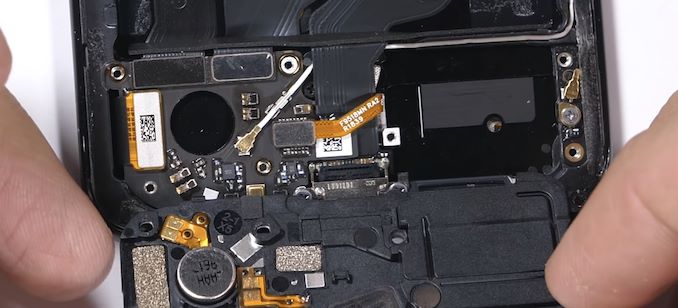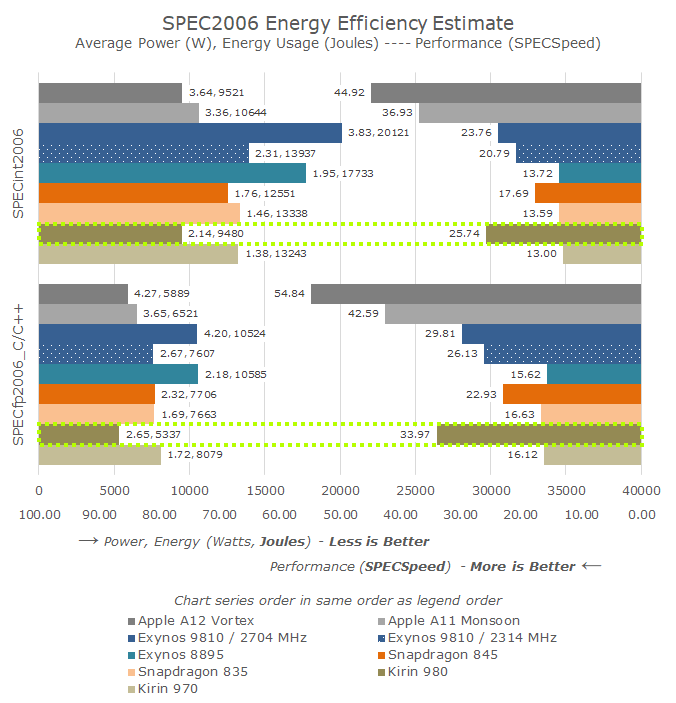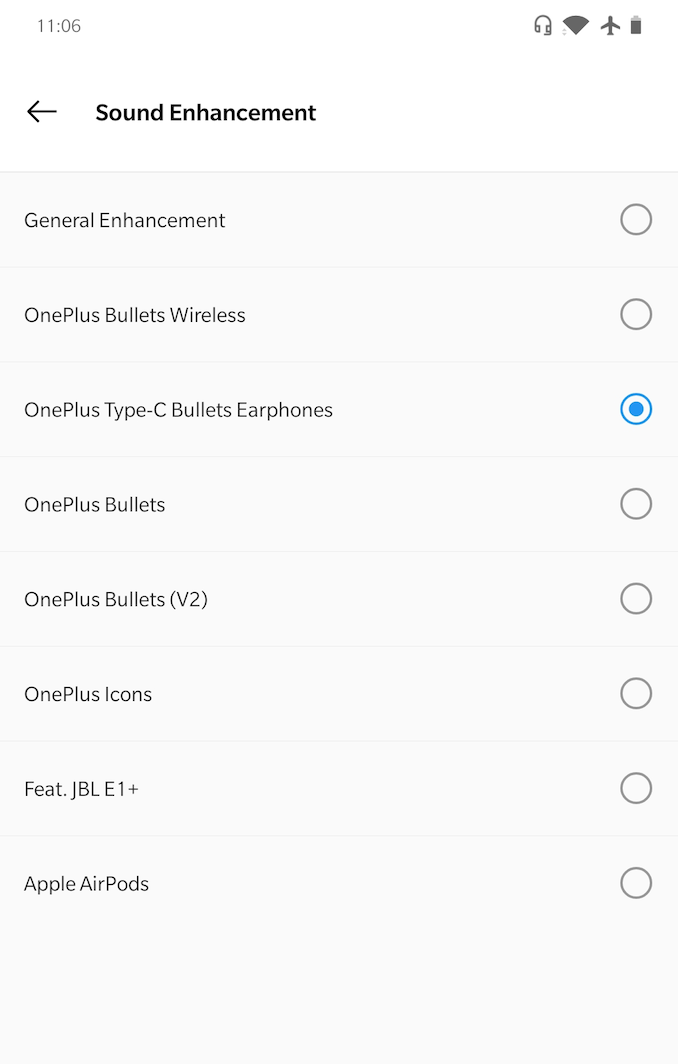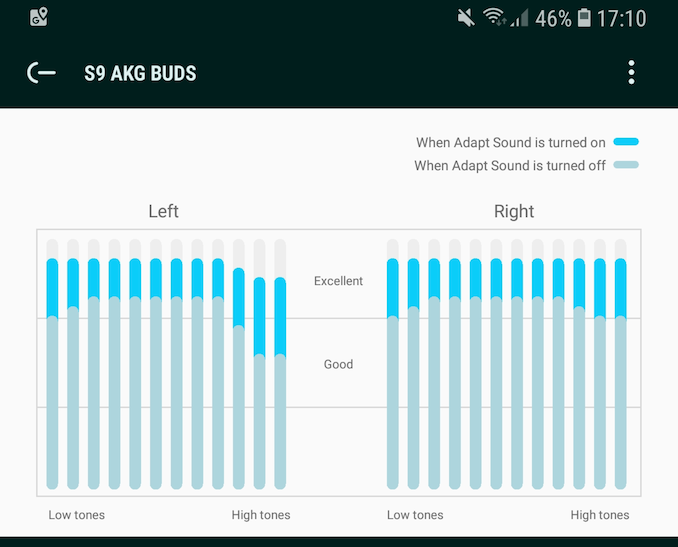AnandTech Year In Review 2018: Flagship Mobile
by Andrei Frumusanu on December 28, 2018 12:00 PM EST- Posted in
- Smartphones
- Apple
- Samsung
- LG
- Huawei
- Mobile
- SoCs
- OnePlus
- Year In Review
The SoC Is the Heart and Most Important Part of a Smartphone
While a few years ago, if you would have asked me what the most important part of a smartphone is, I would have said it’s the screen. In a sense, still many would agree with this today; however I find that smartphones these days have sufficiently good screens that there’s very little to improve on in terms of key characteristics and features. The AMOLED screen of a Galaxy S9 doesn’t offer all that better metrics than that of a Galaxy S6. Of course, there’s new stuff such as HDR, and the displays may have become brighter, but in the grand scheme of things these are just minor iterative improvements rather than defining experiences.
With many vendors now adopting OLED screens in their flagships, I find there’s much less of a differentiation on this aspect of a flagship smartphone. Of course, there’s still a few exceptions to this rule, such as LG notably struggling with the display power consumption of this year’s units, and of course a screen is only as good as it is calibrated.
So leaving the display as less of a major “critical” concern for most of 2018’s flagships, that leaves the SoC as the single most important component. The SoC defines what a smartphone is capable of – from the performance of the phone, to the media features to even how good the camera will perform given the SoC ISP is a key component in this regard. Most importantly alongside performance is of course power efficiency, and both are defined by the design and manufacturing of the silicon SoC.
It’s very much inarguable that 2018 was dominated by the Snapdragon 845: Qualcomm’s SoC powered essentially the vast majority of flagship smartphones, with only a few exceptions in the case of Huawei and naturally of course Apple’s iPhones. Here Qualcomm delivered one of its best SoCs to date, offering an excellent balance between performance and efficiency, all tied together with excellent software driving the hardware. This essentially guaranteed that almost any Snapdragon 845 phone will be an outstanding performer, all while delivering great battery life.
Silicon design is hard and also an expensive billion dollar venture – this is why most vendors rely on commodity components from Qualcomm. On the other side of the spectrum, we have Huawei and Apple as the only two fully vertically integrated vendors, who are also able to design their own silicon. It’s a risky business, however it can also pay off plenty when executed correctly.
An example of this paying off when executed well, is this year’s Kirin 980 as well as Apple’s A12. The new 7nm chips provided new levels of performance and efficiency, augmenting the products beyond that what can be offered by the competition. Both companies’ chipsets, as well as Qualcomm’s, have showcased fantastic improvements in terms of power efficiency.
Apple’s A12 this year especially was able to outshine the competition as we’ve now seen outstanding improvements in performance. This year’s performance jump in particular was significant for Apple – showcasing SPECint2006 speed base scores 15% higher than AMD’s Ryzen 2700X, while also not being very far away from Intel’s best desktop CPUs. We’ll be revisiting this performance comparison in the following months in more detail.
While we had some exemplary showcases on one side, on the other hand Samsung’s Exynos 9810 this year was quite a blunder. The chip initially had great promises, with the first “super-wide” core microarchitecture in an Android SoC. In practice however the SoC had massive issues both in terms of software, as well as just lacking the hardware power efficiency to be able to compete. This was felt no better than in Samsung’s own products: The Galaxy S9’s as well as the Note9’s differ in their SoC internals depending on the market. In practice, while the Snapdragon and Exynos variants very much look the same, they feel like very different devices as the latter has a significant performance and efficiency disadvantage.
2018’s Continued Headphone Jack Removal: Piling on the Stupid and Anti-Consumer Behaviour
2018 has continued to see a lot of companies remove the 3.5mm headphone jack from their smartphones. I’ve never really thought this was a good idea, as to me the reasonings that the companies gave just didn’t make any sense to me. Audio inherently is analog, and moving the internal audio DAC (which was fairly high quality) from being inside the phone to a lower quality DAC being just outside the phone on the connector is one of those things that still boggles my mind till today.
Much of the argumentation in favour of its removal was somehow increased internal space for other components. This seemed a far-fetched marketing argument that just didn’t hold up in practice, as essentially no vendor besides Apple (with the bigger taptic engine) has done anything of substance with the space.
 OnePlus 6 - Credit JerryRigEverything
OnePlus 6 - Credit JerryRigEverything

OnePlus 6T - Credit JerryRigEverything
The recent OnePlus 6T is the most abhorrent example of this as its headphone jack removal has done nothing to change the internal component dimensions on the bottom of the phone, and in place where the jack would be, we find… a slightly shifted vibration motor, and nothing else. This very much looks to be a calculated business move rather than a decision based on any kind of technical merits.
What really does boil my blood though isn’t just the argumentation that it saves on internal space, but that it somehow improves audio quality. Unfortunately this is again just a bad misconception that over the last year or two has now reached absurd levels. The one true technical benefit of having the DAC tightly coupled with a pair of headphones, is that you can tune the DAC to the precise frequency response of the drivers of those headphones, because well, it will never power anything else.
In particular this year’s two most prominent USB-C audio devices, Google’s Pixel USB-C earbuds as well as OnePlus’ Type-C Bullets fail at this exact promise: Google’s units in my experience just have abysmal audio, and you can do nothing about it as the phone offers absolutely no way to tune the audio output. If you plug the headphones in any other device, most of the time you’re also out of luck as most device’s audio equalisation options rely on hardware acceleration via the built-in DAC – but because USB-C audio is just digital pass-through, you’d have to resort to third-party software than pre-processes things on the CPU at increased battery drain.
Again as an example, OnePlus' marketing is very questionable in regard: On their webpage we see the quote:
“Better Audio with a Built-in DAC. We’ve crafted a listening experience that’s immersive, vibrant, and extraordinarily detailed, thanks to an advanced internal DAC with high-res audio support.”
Based on this you would expect the Type-C bullets to offer fantastic sound out-of-the box, yet there’s a hiccup: While the units do sound much better than Google’s, they’re still a far cry from optimal. In the OnePlus 6T’s audio settings we find a “Sound enhancement” option, and here we see OnePlus here provide equalisation presets for a set of popular headphones, among which is their new Type-C bullets. Enabling this option gives a much more optimal frequency response which does notably improve the audio experience.
Now the question here for me is: Why is this a software option on the phone rather something pre-baked into the Type-C Bullet’s DAC out of the factory? Do I also need to mention that in order to use the Type-C headphones on previous OnePlus devices you need to enable OTG in the settings (Which automatically turns off after 10 minutes), and even with this enabled, the OnePlus 6 currently doesn’t even actually offer the equalisation features of the 6T, as it’s only enabled for 3.5mm connected headphones.
3.5mm dongles have also been a complete disaster in the Android ecosystem: To date most smartphones relied on relatively high quality Qualcomm or Wolfson/Cirrus Logic DACs inside the phones, with Qualcomm in particular having made some fantastic strides in audio quality with their in-house ASoCs over recent years.
The same cannot be said of the commodity USB-C to 3.5mm dongles released to date; none of these are even remotely comparable with the performance of good internal DACs, and particularly Google’s bundled units are disastrous in terms of their analog output quality. Here I have to give credit to Apple: the company still seems to be the only one being able offer a 3.5mm dongle who has competitive analog audio output with little compromises. I would not be surprised if Apple’s recently released USB-C to 3.5mm dongle to be vastly superior in audio quality compared to anything offered by Android vendors.
To add insult on top of injury – companies are now starting to advertise the lack of a headphone jack as a premium feature. We addressed the OnePlus 6T, but also Huawei’s Mate 20 Pro not having a headphone jack, while its lesser sibling, the Mate 20 having one, is again some sort of nonsensical product segmentation which seems to be designed to simply generate more accessory sales. In this case you’re paying more for a phone to have a lesser feature.
Samsung, and partly LG, seem to be the only companies who are resisting this anti-consumer trend. Here Samsung in particular seems to have absolutely no issues in “managing its internal component space”, all while providing the best audio experience in the mobile space. It still surprises me that Samsung is still the only company to offers an actual audio calibration option via its Adapt Sound feature – a psychoacoustic feedback equalisation feature that will tune the audio output of its internal DAC to an experienced flat frequency response based on your particular headphones and your particular hearing. I vehemently urge Samsung to continue on their current path, as the competition can't seem to stop blindly shooting themselves in the foot.
Overall, 2018 has been a year of sheer stupidity when it comes to the topic of audio, 3.5mm headphone jacks, and USB-C audio. Companies will need to reconsider their strategies, and consumers who value actual good audio quality will need to vote with their wallets.













65 Comments
View All Comments
Andrei Frumusanu - Friday, December 28, 2018 - link
> "Much better experience to your ears" is about as subjective a line as one could drop. Perception is different from ear to ear and person to person.You don't understand what subjective is.
Because perception thresholds are different for different persons, that is precisely exactly why a mechanism such as AS will be able to produce the single best result out of any audio product, and will be able that will be able to reproduce as near to an intended flat FR as possible.
The AS calibration procedure is a series of binary tests on whether you can hear a low amplitude frequency or not, this is not a subjective evaluation but an empirical determination with a consice answer of yes or no. It doesn't ask you if something sounds good or not, nor does it give you any control over the result, instead it spits a correctly compensated curve based on your hearing.
Shekels - Sunday, December 30, 2018 - link
The problem with AS is that it's on the S9. It can't power high fidelity headphones so what's the use of it producing a flat sound to your ears if the low grade earphones can't even produce close to accurate sound...SkyBill40 - Friday, December 28, 2018 - link
As a side note (and since I can't edit my comments), I understand that this is, in effect, an opinion piece. Given that, perhaps I should have approached my commentary slightly different. My intention was not to argue with you based on the premise of my opinion being better than yours because it's different, but instead to elicit productive conversation on the topic that isn't presented in quite as matter-of-fact as it has been thus far seeing that other testing reviews stand largely contrary to what you've stated here.Thanks for the discussion all the same, Andrei.
Andrei Frumusanu - Friday, December 28, 2018 - link
My "opinions" here on the topic are based on extensive testing with audio measurement equipment (electrical in terms of analog output, as well physical in terms of SPL out of units) on all the discussed devices. Just because I haven't written it down in a dedicated piece doesn't make it less "matter-of-fact" than anything else you might have seen.Krampus1999 - Saturday, December 29, 2018 - link
Skybill is correct, it's an opinion piece and opinions are subjective. When researching LG is well known for having some of the best sound quality, just as the Pixels are known for having the best camera's but you let your bias show in both counts.Shekels - Sunday, December 30, 2018 - link
https://www.audiosciencereview.com/forum/index.php...I urge you to read this. The LG G7 quad dac offers objectively superior sound quality than the Galaxy S8, and the S9 by a long shot. Saying otherwise as fact is simply wrong. The only reason to use the Quad Dac is with HiFi headphones like Sennheiser HD6XX (bottom line HiFi, 200USD so pretty much anyone can get them) so saying that's the only case where the G7 is better is just ridiculous. That's what it was meant for. Not to power your crappy 50$ earbuds. The S9 couldn't even power the HD6XXs. I've tried that combo and there is 0 bass, highs are screechy and the mids seem like they're 100 yards away. My Xiaomi Mi Mix 2 with it's dongle produces vastly superior audio quality to the S9 with high impedance headphones let alone the G7. Also Adaptive Sound barely changes anything (I can pretty much hear all the frequencies so it doesn't change much) and I noticed it introduced a bit of distortion and things just didn't sound as well when I used it. How the phones sound TO YOU are purely subjective. The output quality is obiective, and the G7 stomps the S9. Saying otherwise would be like saying a Civic can lap the nordschleife faster than a Porsche 911 GT2. You might like to drive the Civic more and feel like it drives nicer, but it sure as hell gets it's a$$ wooped in a race against the 911 GT2
aswool - Saturday, December 29, 2018 - link
Saying the Aqstic DAC in the Snapdragon devices is better than the Cirrus Logic is flat out wrong.However, I'm curious what lead you to that conclusion.
Objectively speaking, the DAC is the only redeeming part of the Exynos S9 this year.
Andrei Frumusanu - Saturday, December 29, 2018 - link
I measured the Snapdragon S9's to have better output power and lower THD than the Exynos S9's. In fact the Exynos has pretty much worse output than a vast majority of devices this year.Qualcomm has made great strides in the ASoCs the last couple of years.
Quantumz0d - Sunday, December 30, 2018 - link
Sorry I don't see how you see the distortion on the LG Audio with the ESS9218P DAC chip is a HiFi SoC which is only of its kind basically a patented hardware with multiple channels of Audio processing functionality of a Delta Sigma DAC from my knowledge with superb clarity, I might not know much of its hardware functionality, like you might have known. And there's a huge misconception among people that you need to trick it to high impedance mode and all for the QuadDAC to work which is wrong, Also how LG did the job on maintaining only lowest level DAC channels with a normal gear and go up with 3 modes (I think the primary reason is battery consumption by the ESS SoC due to it's supreme powerful nature as all in one)This is an AA piece on the LG V20 DAC which is good to learn stuff.
https://www.androidauthority.com/lg-v20-quad-dac-e...
But here are my impressions of it, vs my iPod 5.5G / iPod 6G / SGS i9000 with Voodoo mod all with one IEM Dunu DN 1000 (I have tried VSonic GR07 BE they were great but have Bass lacking severely and IE80s which have bad Audio due to Veil, the Triple Driver is very good in DN1Ks, Joker's theheadphonelist review is really great, checkout his site, his reviews are very very good and would apply to many)
https://theheadphonelist.com/headphone_review/dunu...
iPod 5.5G is very famous for the Wolfson DACs house sound due to it's lush 3Desque sound and the 6G moves away with a more "accurate" sonic performance making it fatiguing due to the metallic effect it has its powered by Cirrus Logic due to tightening of the Bass vs the 5.5Gs Audio performance.
The i9000 is one of the rare phones which has a full fledged Audio performance on a custom ROM, huge thanks to Supercurio, famous Android Developer for the Audio mod on it thanks to Wolfson drivers for the DAC chips. This paved way for the SGS III to have some similar functionality. The i9000 has all the settings from Dynamic Range to the Bass customization from the Mid / Sub Bass levels and the Analog DAC bypass processing for everything on phone. However the i9000 DAC performance falls short vs the iPod 5.5G due to the latter having more spacious soundstage allowing for more airy performance but it's not bad in any means it can be classified as warm signature, the clarity is superb on the iPods as a reason and very much engaging sound. Both are running 200GB SD cards. Even iPod as well, thanks to aftermarket modding community that device has more shelf life than any technology product I've came across with again a parametric EQ from Rockbox, OSS Linux OS. Mind you this is before Cirrus Logic bought them out sadly.
I was eyeing for a device which has good specs and feels great in hand that devices is none other than LG V30. It's very solid piece has exact dimensions as an OP3 yet has more in everything, the width is nor narrow and stupid like Samsung or iPhones and the camera doesn't have any bumps has this wide angle and USB to HDMI and lot.
The HiFi quad DAC, the end game. Read a lot and was skeptical, I've experimented various Digital Filters which I think is a good option but the presets are bad IMHO, The sound is simply magical, same IEMs, Dunu DN 1000, The Visceral deep bass is just pleasing and solid clarity the issue was sibilance due to TWFK drivers and more low end emphasis, mind you the clarity is still great it stomps over RHA MA750s and downside was little congested mids and sharp highs on all the devices I have. Perhaps the iPod 6G needs a revisit But the LG V30 just drives them beautifully to my surprise the fatiguing factor due to TWFKs was smoothed out and left with polished lush deep sub bass, a sub-woofer in ear with rich texture sound for all frequencies and retaining the clarity the mids were pleasing and highs as well, extremely clear sound, melodic, a totally immersive eargasmic pleasure the V30 delivers vs those Wolfson DAPs esp the iPod 5.5G which I developed a bond with, the mids and highs are so well textured and spread out to let you enjoy all those tunes on the V30. I would like to let you guys know that I tried all HIM (High Impedance Mode) and AUX modes through tavil XML files from WhiskeyOmega at XDA to trick the DAC as many want with the DN1K, And I was expecting something but ruined the sound since it reduces the volume and even raising one point up is resulting in bad quality to my ears, I think LG Engineers did a perfect job with the 3 modes of Normal, AUX, HIM as demanded by the headset. Forcing the headphone output made it sound uneven, sharp and unpleasant to even ramp up the volume a bit also idk how people are magically experiencing higher quality Audio, I already lost a lot of my hearing due to IEMs, a gain switch are what those mods are to my ears.. Did A/B testing with my DAPs and the V30 is the clear winner.
Plus the mention you said turn off, the DAC switch works by default with the LG phones, the switch on/off will have huge impact only to the HIM gear like my HD 6XX ( Only phone which could drive them, however the AMP needs more power and phone is hard, a Schiit Stack would do wonders here) The DAC kicks in the moment we plug the earphones into the 3.5mm jack, the Digital filters will be working along with only few processing lanes with the low impedance gear until 30Ohm and the AUX mode kicks in delivering the audio output as needed by the higher impedance gear and then the 50OHm+ HIM mode kicks in driving all lanes in the 9218P chip.
This post on XDA explains in a better way about the DAC modes I hope..
https://forum.xda-developers.com/showpost.php?p=78...
I've listened to the SD820 and SD835 sound and they are hollow sounding both in a car and earphone line out. Also the Adaptive Audio is done by HTC10 as well, and that phone HTC10 outshines every phone from Samsung and LGV30 beats it as well, this is according to a lot of Head-Fi'ers. V40 is having some discrepancies due to the Meridian tuning as its lost all it's lush sound for more neutral/clinical sound, See it's not always numbers. Since this topic is highly subjective it's hard to conclude. Also an important note, the DAC itself doesn't matter the Implementation matters MOST, the Sabre ESS chips are notorious for their glaring clinical sound the LGV30 is not in that. It's a wonderful implementation.
But here's another Head-Fi thread on the smartphone Audiophile stuff. Also the ESS9128 and ESS chips are used in highly appreciated gear which is rivaled by the solid DACs from Asahi Kasei Micro, AKM4490 which is in the ZTE Axon 7 and runs on Lineage OS as well. Also there in Schiit Modi and Jotunhiem / iBasso too.
On an ending note,
For wired sets, Look at RHA (MA750), iBasso (IT01), Alpha Delta (AD01- Dual DD driver), Fiio EX II/Dunu Titan1 ($50, Fantastic IEM), Yamaha EPH 100, TFZ King II, and the superb performer - VSonic GR07 BE/Classic which beats IE80 (veiled sound due to mid bass leak) and a lot of higher priced IEMs but less Bass rest all perform solid. Go up a bit high for more dynamic sound and multi driver earphones like Fiio FH1 or F9, Dunu DN1000/2000, 1More Triple/Quad, Shures no BS lossy or lag or any gimmicks and keep them for longer period and high quality, with supreme sonic audio performance with Multi Driver setups. I'd quote the beast FLC 8N for its super dynamic tunable hardware like the RHA T20s and AKG K3003, Shure SE846. But far more affordable and bang for buck and TOTL vs those puny stupid Jaybird or Airpods with stupid cheap drivers.
Quantumz0d - Sunday, December 30, 2018 - link
https://www.head-fi.org/threads/best-smartphone-fo...Forgot to post this.